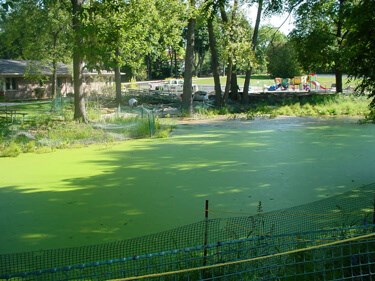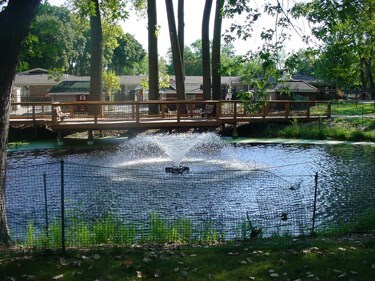Articles and Press
Pond Dynamics and Summer
As the seasons change so do pond and lake dynamics. Temperature and light serve as two primary factors that cause seasonal variations in water quality. Biological activity is also heavily impacted and even more so during summer. An understanding of these factors allows a person to find timely solutions to all their water quality management problems. However, people often tend to focus on the symptoms of struggling ponds and lakes (algae, odors, etc.) as opposed to the causes. The focus doesn’t switch to water quality management until the symptoms are obvious.
Temperature
Temperature significantly impacts all types of plant as well as animal life in an aquatic ecosystem. Since few warm-blooded animals inhabit a pond or lake, the effects of warmer temperatures are very important. Fish and other types of cold-blooded species experience increases in their metabolic rate with the increase in temperature. As it continues to increase so do the metabolic rates of bacteria and protozoa (Mother Nature’s “garbage disposals”). Digestion rates (and in turn oxygen demand) are also tied to water temperature; the higher the temperature the greater the rate of decomposition.


Light
Additionally, light plays an important role in the process of photosynthesis. Increases in light create rises in photosynthetic rates of plants and during the summer they grow at their maximum rates! Bottom rooted weeds and algae may seem barely manageable.

Nutrient Loading
The only constant you can count on in summer is nutrient loading in ponds or lakes. Non-source pollutants and fertilizers will continue to find their way into water at peak levels. Leaves, water fowl, fish waste, dead/dying aquatic plants (including algae) sink to the bottom. This results in an increase of the bacterial digestion rates, nutrient levels and biological oxygen demand. Such increases throw a pond out of balance, adding to the sludge bed or the “aquatic compost” pile at the bottom of a pond or lake. This sludge is guaranteed to give the lake manager bigger headaches in the coming year.
Summer conditions create a need for supplemental aeration; this allows decomposition to occur at its maximum rate. Plant life changes significantly as well during this season, thanks to the warmer temperatures, higher nutrient levels and light associated with it. As previously mentioned, this creates a high demand for oxygen when a pond’s ability to provide it is at its all-time low. Aeration systems give a pond or lake the extra boost it needs to remain healthy and keeps water quality high during the summer.
Improve water quality & create beautiful water features - the EASY way!
Otterbine can keep your pond healthy and clean - find out how!
Offering consultation and design services that are supported by over 300 factory trained sales and service centers - we are here to answer your questions and provide a solution!
